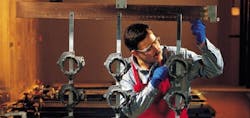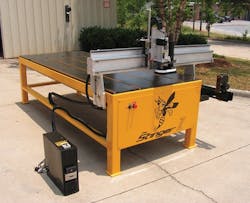In 2011, Aaron Hand was the managing editor for Control Design and Industrial Networking.
As a small machine builder in Cartersville, Ga., CAMaster makes CNC routers and plasma cutters primarily for cabinetry, woodworking and sign making, not to mention hobby lines in everything from life-size chess pieces to Star Wars replica costumes. Customers range from small shops in South America to globally recognized names like Fender, which uses CAMaster machines to make guitar necks, and Bose, which relies on the larger machines for its huge stadium speaker boxes.
Simplicity has always been what sells for CAMaster, says Joey Jarrard, president and co-owner. He's a big believer in the KISS motto — keep it simple, stupid. "Some of the larger machine manufacturers, they really have gone out of their way to make everything as complicated as possible," he says. "I was an end user before. I ran a cabinet shop for about six years, and it was very frustrating."
CAMaster instead tries to take the learning curve out of its machines, keeping the controls and interface as simple as possible. "One screen is all they have to function with," Jarrard says. "They can have 10-20 buttons on it sometimes, but it's just one screen. It's very easy to navigate; very easy to learn. My 11-year-old son can run our machines."
CAMaster is a small company with about 12 employees, two of whom are controls engineers. Larger competitors often write their own control software, Jarrard says, but he prefers to let other companies provide that expertise, so CAMaster uses third-party control software. "They spend all day thinking about their control software," Jarrard says. "I can fall back on their knowledge."
There are other cases where Jarrard has been happy to fall back on somebody else's expertise, such as a relatively new microstepping technology from Testra. CAMaster uses servo motors from Teknic for its larger Cobra line of CNC routers because they enable the machines to run quickly, at a high amperage for larger jobs. The Stinger line of CNC routers, however, have traditionally had stepper motors to reach a better price point for smaller customers.
CAMaster's president is a firm believer in KISS—keep it simple, stupid.
Microstepping technology has improved the smoothness and accuracy of steppers, but can still be subject to vibration, noise and harmonic resonance issues. Testra's SoftStep technology was very quiet, smooth and accurate, Jarrard says. "It got us as close as we could get to the performance of servos as far as smoothness of movement and speeds we wanted to see," he says. But where the servos cost about $1,000 an axis, he says, the SoftStep motors are more like $300 per axis.
"The cut quality, quietness of motors, the motor staying cooler — it all goes hand in hand with a top-quality machine," Jarrard says. "The motion is fluent. The machine doesn't growl or jerk — it's smooth, with very well engineered movement."
Jarrard says that being able to offer a smaller router with performance close to a servo-based machine can even enable solutions to a big company like Bose, which is focused on a "lean manufacturing" program, using smaller machines that are easier to run and easier to maintain. It provides manufacturing flexibility because Bose can grab anyone off the floor to run that machine, Jarrard says.
About the Author
Aaron Hand
Aaron Hand

Leaders relevant to this article:


